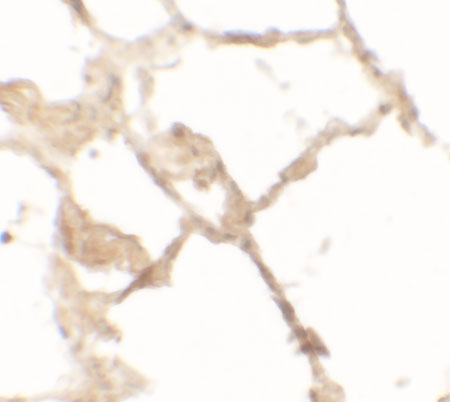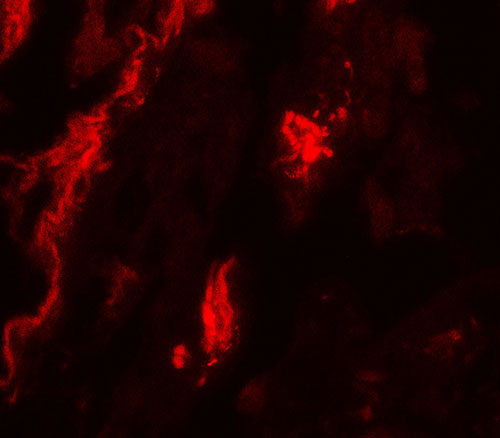TFEB Antibody
- 产品详情
- 实验流程
- 背景知识
Application
| IF, E, IHC-P |
|---|---|
| Primary Accession | P19484 |
| Other Accession | NP_009093, 24307933 |
| Reactivity | Human |
| Host | Rabbit |
| Clonality | Polyclonal |
| Isotype | IgG |
| Calculated MW | 52865 Da |
| Concentration (mg/ml) | 1 mg/mL |
| Conjugate | Unconjugated |
| Application Notes | TFEB antibody can be used for detection of TFEB by immunohistochemistry at 2.5 µg/ml. |
| Gene ID | 7942 |
|---|---|
| Other Names | Transcription factor EB, Class E basic helix-loop-helix protein 35, bHLHe35, TFEB, BHLHE35 |
| Target/Specificity | TFEB; TFEB antibody is human specific. At least three isoforms of TFEB are known to exist. |
| Reconstitution & Storage | TFEB antibody can be stored at 4℃ for three months and -20℃, stable for up to one year. |
| Precautions | TFEB Antibody is for research use only and not for use in diagnostic or therapeutic procedures. |
| Name | TFEB {ECO:0000303|PubMed:2115126, ECO:0000312|HGNC:HGNC:11753} |
|---|---|
| Function | Transcription factor that acts as a master regulator of lysosomal biogenesis, autophagy, lysosomal exocytosis, lipid catabolism, energy metabolism and immune response (PubMed:21617040, PubMed:22343943, PubMed:22576015, PubMed:22692423, PubMed:25720963, PubMed:30120233, PubMed:31672913, PubMed:32612235, PubMed:32753672, PubMed:35662396, PubMed:36697823, PubMed:36749723, PubMed:37079666). Specifically recognizes and binds E-box sequences (5'-CANNTG-3'); efficient DNA-binding requires dimerization with itself or with another MiT/TFE family member such as TFE3 or MITF (PubMed:1748288, PubMed:19556463, PubMed:29146937). Involved in the cellular response to amino acid availability by acting downstream of MTOR: in the presence of nutrients, TFEB phosphorylation by MTOR promotes its cytosolic retention and subsequent inactivation (PubMed:21617040, PubMed:22343943, PubMed:22576015, PubMed:22692423, PubMed:25720963, PubMed:32612235, PubMed:32753672, PubMed:35662396, PubMed:36697823). Upon starvation or lysosomal stress, inhibition of MTOR induces TFEB dephosphorylation, resulting in nuclear localization and transcription factor activity (PubMed:22343943, PubMed:22576015, PubMed:22692423, PubMed:25720963, PubMed:32612235, PubMed:32753672, PubMed:35662396, PubMed:36697823). Specifically recognizes and binds the CLEAR-box sequence (5'-GTCACGTGAC-3') present in the regulatory region of many lysosomal genes, leading to activate their expression, thereby playing a central role in expression of lysosomal genes (PubMed:19556463, PubMed:22692423). Regulates lysosomal positioning in response to nutrient deprivation by promoting the expression of PIP4P1 (PubMed:29146937). Acts as a positive regulator of autophagy by promoting expression of genes involved in autophagy (PubMed:21617040, PubMed:22576015, PubMed:23434374, PubMed:27278822). In association with TFE3, activates the expression of CD40L in T-cells, thereby playing a role in T-cell-dependent antibody responses in activated CD4(+) T-cells and thymus-dependent humoral immunity (By similarity). Specifically recognizes the gamma-E3 box, a subset of E-boxes, present in the heavy- chain immunoglobulin enhancer (PubMed:2115126). Plays a role in the signal transduction processes required for normal vascularization of the placenta (By similarity). Involved in the immune response to infection by the bacteria S.aureus, S.typhimurium or S.enterica: infection promotes itaconate production, leading to alkylation, resulting in nuclear localization and transcription factor activity (PubMed:35662396). Itaconate-mediated alkylation activates TFEB- dependent lysosomal biogenesis, facilitating the bacteria clearance during the antibacterial innate immune response (PubMed:35662396). In association with ACSS2, promotes the expression of genes involved in lysosome biogenesis and both autophagy upon glucose deprivation (PubMed:28552616). |
| Cellular Location | Nucleus. Cytoplasm, cytosol. Lysosome membrane. Note=Mainly present in the cytoplasm (PubMed:23434374, PubMed:33691586, PubMed:35662396). When nutrients are present, recruited to the lysosomal membrane via association with GDP-bound RagC/RRAGC (or RagD/RRAGD): it is then phosphorylated by MTOR (PubMed:23401004, PubMed:32612235, PubMed:36697823). Phosphorylation by MTOR prevents nuclear translocation and activity by promoting interaction with 14-3-3 proteins, such as YWHAZ (PubMed:22343943, PubMed:22692423, PubMed:23401004, PubMed:25720963, PubMed:32612235, PubMed:32753672, PubMed:35662396, PubMed:36697823, PubMed:37079666). Under aberrant lysosomal storage conditions, it translocates from the cytoplasm to the nucleus (PubMed:21617040, PubMed:22576015, PubMed:23434374, PubMed:25720963, PubMed:32753672). The translocation to the nucleus is regulated by ATP13A2 (PubMed:23434374, PubMed:27278822). Conversely, inhibition of mTORC1, starvation and lysosomal disruption, promotes dephosphorylation and translocation to the nucleus (PubMed:22343943, PubMed:22692423, PubMed:37079666). Exported from the nucleus in response to nutrient availability (PubMed:30120233). In macrophages, translocates into the nucleus upon live S.enterica infection (PubMed:27184844). |
For Research Use Only. Not For Use In Diagnostic Procedures.
Provided below are standard protocols that you may find useful for product applications.
BACKGROUND
The Transcription factor EB (TFEB) is a member in the basic helix-loop-helix leucine zipper superfamily of transcription factors that is translocated in a subset of renal tumors (1,2). Recent studies have shown that lysosomal biogenesis is regulated by TFEB (3), which is in turn regulated by the mammalian target of rapamycin (mTOR) complex 1 (4). Other evidence suggests that TFEB coordinates the major steps of the autophagic pathway by driving the expression of autophagy and lysosomal genes (5).
REFERENCES
Carr CS and Sharp PA. A helix-loop-helix protein related to the immunoglobulin E box-binding proteins. Mol. Cell Biol. 1990; 10:4384-8.
Davis IJ, Hsi BL, Arroyo JD, et al. Cloning of an alpha-TFEB fusion in renal tumors harboring the t(6;11)(p21;q13) chromosome translocation. Proc. Natl. Acad. Sci. USA 2003; 100:6051-6.
Sardiello M, Palmieri M, di Ronza A, et al. A gene network regulating lysosomal biogenesis and function. Science 2009; 325:473-7.
Pena-Llopis S, Vega-Rubin-de-Celis S, Schwartz JC, et al. Regulation of TFEB and V-ATPases my mTORC1. EMBO J. 2011; 30:3242-58.
终于等到您。ABCEPTA(百远生物)抗体产品。
点击下方“我要评价 ”按钮提交您的反馈信息,您的反馈和评价是我们最宝贵的财富之一,
我们将在1-3个工作日内处理您的反馈信息。
如有疑问,联系:0512-88856768 tech-china@abcepta.com.























 癌症的基本特征包括细胞增殖、血管生成、迁移、凋亡逃避机制和细胞永生等。找到癌症发生过程中这些通路的关键标记物和对应的抗体用于检测至关重要。
癌症的基本特征包括细胞增殖、血管生成、迁移、凋亡逃避机制和细胞永生等。找到癌症发生过程中这些通路的关键标记物和对应的抗体用于检测至关重要。 为您推荐一个泛素化位点预测神器——泛素化分析工具,可以为您的蛋白的泛素化位点作出预测和评分。
为您推荐一个泛素化位点预测神器——泛素化分析工具,可以为您的蛋白的泛素化位点作出预测和评分。 细胞自噬受体图形绘图工具为你的蛋白的细胞受体结合位点作出预测和评分,识别结合到自噬通路中的蛋白是非常重要的,便于让我们理解自噬在正常生理、病理过程中的作用,如发育、细胞分化、神经退化性疾病、压力条件下、感染和癌症。
细胞自噬受体图形绘图工具为你的蛋白的细胞受体结合位点作出预测和评分,识别结合到自噬通路中的蛋白是非常重要的,便于让我们理解自噬在正常生理、病理过程中的作用,如发育、细胞分化、神经退化性疾病、压力条件下、感染和癌症。







